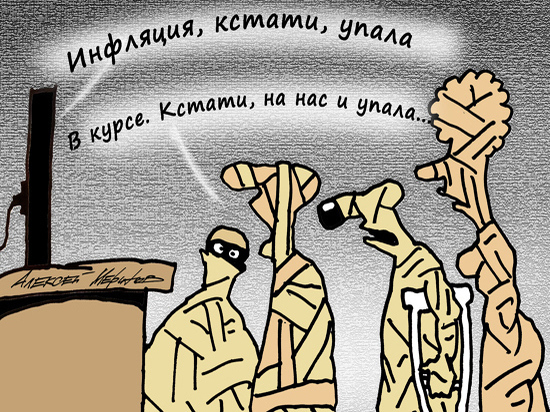The rate fell from 10.9% to 3.3%
It's hard to believe, but annual inflation in Russia as of the beginning of April has weakened to 3.3%, while the total a month ago it was 10.9%. That is, for the first time in a long time, the consumer price index fell below the target of the Central Bank of 4%. Can this be considered an unconditional basis for joy? From the high stands they give us to understand: in the future the situation will only improve. In particular, inflation is expected to be less than 3% by the end of April, which is true.

And what to expect in May, June, autumn? Obviously, the current positive is short-term and should not mislead anyone. And there is no magic here — just simple arithmetic. In March last year, inflation amounted to 16.7% in annual terms (in April — 17.8%), having increased by 7.6% compared to February. If you subtract the last figure from 10.9% (February 2023), you get just 3.3%. And now the “high base effect” of that force majeure, fiery spring of 2022 has worked, when the ruble sharply weakened due to sanctions, there was a surge in consumer demand, and as a result, prices for almost all goods and services accelerated. That is, the current «victory over inflation» is purely arithmetic. And professional financiers are fully aware of this. The head of the Central Bank, Elvira Nabiullina, warned: “This (decrease) will only reflect high values coming out of the calculation of annual inflation at the peak of the rise in prices in March-April last year, and not the current inflation picture.”
The problem is also that the data of Rosstat categorically diverge from the personal feelings of everyone who goes to the store for shopping. The sensations are the same, but the statistical inflation is completely different. And what about this global dissonance? In our picture of the world, in our subjective consumer space, prices are constantly rising, with the inexorability of fate — from year to year, from month to month. And in the case of the state (according to its calculation methods), they are not so severe and sometimes even allow themselves to fall. That is, they get their inflation by subtraction, but for us it only grows — albeit at different rates.
However, here it is also a matter of the preferences of the layman, who, as a rule, buys the same products in the same store. Rosstat, on the other hand, operates with a variety of components — from the cost of tickets for Russian Railways and air transport to infant formula. The majority of ordinary consumers have a rather narrow set of priority products. For example, it does not include building materials and consumer electronics, which have become cheaper in recent years. And the fact that cucumbers have risen in price by 58%, metro fares — by 8%, utilities — by 13.5% (due to double indexation of tariffs last year), people notice right away.
But the main thing is that today the pro-inflationary risks clearly dominate (in quantitative and qualitative terms) over the factors working to reduce prices, such as the stagnation of effective demand and the reduction in imports. The conditions of foreign trade are deteriorating, logistics is becoming more complicated, the profits of raw materials exporters and oil production are falling, the labor market is overheating, the ruble exchange rate is steadily weakening, housing and communal services tariffs are rising, as well as the costs of producers (primarily in the agricultural sector) due to the rise in prices for components, raw materials and materials. In order not to work at a loss, companies are forced to raise selling prices. Plus, since January, excise taxes on tobacco and alcohol, as well as taxes for the oil industry (MET — mineral extraction tax), have been increased, and this is fraught with an increase in car fuel prices.
Income to the state budget is getting smaller, and the difference between revenue and expenditure is increasing. The monetary authorities have no choice but to increase the domestic money supply with insufficient commodity coverage. Finally, the real wages of Russians are in steady opposition to inflation, falling or, at best, stagnating. This topic is inseparable from the macroeconomic context. For example, if we take private business, retail trade and services, last year the turnover of many companies decreased by tens of percent. In the face of endlessly rising costs, employers are forced to minimize investments in the wage fund, cut bonuses and bonuses, transfer staff to a shorter working day or week. There is no talk of indexing wages to the level of inflation. And these are systemic circumstances that play in the long run. Exactly the same dramatic consistency is inescapably present in the dynamics of consumer prices. It is a path in only one direction — up. Well, a sharp decline is nothing more than paper manipulations of statistical methods. They are not applicable to real life.


